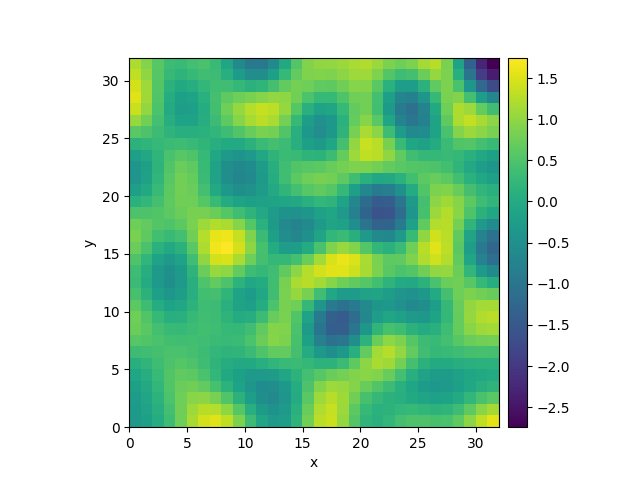Note
Click here to download the full example code
2.6. Kuramoto-Sivashinsky - Using PDE class¶
This example implements a scalar PDE using the PDE. We here
consider the Kuramoto–Sivashinsky equation, which for instance
describes the dynamics of flame fronts:
\[\partial_t u = -\frac12 |\nabla u|^2 - \nabla^2 u - \nabla^4 u\]

0%| | 0/10.0 [00:00<?, ?it/s]
Initializing: 0%| | 0/10.0 [00:00<?, ?it/s]
0%| | 0/10.0 [00:13<?, ?it/s]
0%| | 0.01/10.0 [00:22<6:16:29, 2261.19s/it]
0%| | 0.02/10.0 [00:22<3:08:03, 1130.62s/it]
1%|1 | 0.11/10.0 [00:22<33:53, 205.57s/it]
41%|####1 | 4.13/10.0 [00:22<00:32, 5.48s/it]
41%|####1 | 4.13/10.0 [00:22<00:32, 5.48s/it]
100%|##########| 10.0/10.0 [00:22<00:00, 2.26s/it]
100%|##########| 10.0/10.0 [00:22<00:00, 2.26s/it]
from pde import PDE, ScalarField, UnitGrid
grid = UnitGrid([32, 32]) # generate grid
state = ScalarField.random_uniform(grid) # generate initial condition
eq = PDE({"u": "-gradient_squared(u) / 2 - laplace(u + laplace(u))"}) # define the pde
result = eq.solve(state, t_range=10, dt=0.01)
result.plot()
Total running time of the script: ( 0 minutes 22.866 seconds)